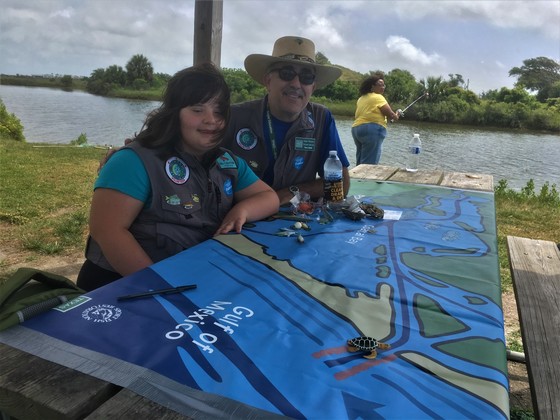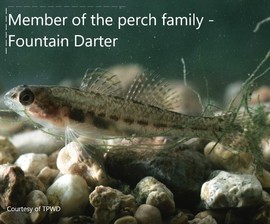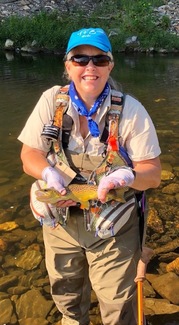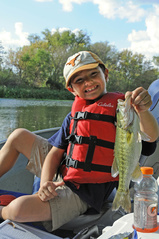In This Issue:
By Terry Smith, TPWD Volunteer Area Chief

Photo courtesy of Terry Smith.
Like my dad, I grew up fishing and camping. It’s just what we did along with baseball and bicycles. Along came marriage then two kids, resulting in less fishing and no camping, but plenty of family activities. Then came our third child Jennifer, born in August of 2000 with Down Syndrome with a host of health issues and disabilities. We continued to enjoy the outdoors as much as we could; swimming, boating and a little fishing.
In 2015, when Jennifer was entering her last year of junior high school, I took an early retirement to be home when she gets out of school and run her to doctor appointments as well as Special Olympic activities. When I got bored, I started volunteering with Sea Center Texas and was still able to be home when Jennifer got out of school. Sea Center also welcomed Jennifer to join in events. Looking for more opportunities, I joined TPWD Angler Ed. but noticed that there were few, if any, kids with disabilities attending and didn’t see any events on the website for those kids. When the school couldn’t get to Sea Center I asked Jennifer’s teacher if I could bring the fishing to her kids. It took a bit of time and convincing, but I finally got the approval. With Backyard Bass gear, an Instructor Kit and assistance from the AWESOME Michael Scherer (this was my first event) we brought TPWD into the school. Jenn’s teacher said don’t treat these kids any different, so we didn’t. We started with Fish ID and Trash Talk and then finished with fishing in the gym. We had to adjust a bit, but the kids and teachers loved it and we’ve been going back now for 3 years.
Jennifer and I now do outreach events at 2 elementary schools, 1 junior high and 1 high school within our local district. We also do yearly events at a Houston school for Down Syndrome kids, where Jenn once attended. We even presented at an event in Austin for a summer camp, as well as a Junior Angler class to a local group for adults with disabilities.
I’m not sure if all the kids understand the information and activities we provide, but we are always welcomed with smiles and hugs. Some kids want to know when we are coming back and look forward to our return. And shame on me if I don’t bring Jennifer! She has her fans at each school.
I’ve had numerus people ask if it’s worth the effort. A lot of driving, loading, unloading, cleaning, a truck that smells like fish, etc. It does take effort from myself and TPWD staff, but to have the kids engaged, see their smiles and hear their laughter make it all worth it. It also greatly benefits Jennifer’s social skills. She can pretty much identify common saltwater and freshwater fish. This isn’t just about Jennifer and me, as there are many other awesome TPWD volunteers that spend their time and effort supporting us with these kids. It is so worth it!
A special thanks to those volunteers who help at my events that bring extra patience and understanding with them. Especially, to Greg Akins who gets constant calls from me telling him “this is what I want to do” or asking for equipment for an event. As well as assisting on those events when available. Also, to the staff at Sea Center for the portable touch tank, “live & dead” marine animals as well as borrowing equipment. Last but not least, my wife who also helps at some events and lets me use her formal dining room as an equipment staging area. I do have to clear it out when entertaining. However, it is all worth it!
By Adam Comer, TPWD Aquatic Education Training Specialist
After years of fishing, you’ll undoubtedly have a conversation with another angler, “Looks like a Rock Bass”, “No, I’d say that’s a Goggle-Eye”. Two names for the same fish; one name highlights the fish’s thicker body, preferred habitat, or coloration, the other name refers to the distinctive large red colored eyes. Then who’s right? Fish Biologists prefer the scientific name to avoid confusion with regional colloquial names. In this case, Rock Bass or Ambloplites rupestris is in the Sunfish family, with Abloplites meaning “blunt shield” and rupestris meaning “living among the rock” in Latin. Nevertheless, I personally feel colloquial common fish names connect us to cultural and historical themes. Below are three notable colloquial fish names and their origins.

Perch: arguably the most commonly misused and synonymous with smaller fish, especially types of sunfish. Origins of the word perch can be traced to “perke”, from Ancient Greece, meaning spotted or speckled. Taxonomically, Perch are considered fish species in the Percidae family. Only three North American sport fish are members of the Perch family – Yellow Perch, Walleye, and Sauger. None of the three mentioned are native to Texas, instead they are hatchery-raised and stocked by TPWD. According to the TPWD stocking webpage, Walleye is the only species stocked in the state in recent years. However, Texas does have 21 native small nongame freshwater fish species in the Percidae family, comprised of darters and logperch. Only growing to several inches, darters and logperch typify the long, rounded perch form with an incredible variety of colors and patterns.
|
Freshwater Drum or Gaspergou: pronounced gas·per·gou, gaspə(r)gü, is found in a variety of freshwater habitats across North America and has been found feeding on zebra mussels. Brad Littrell, Fisheries Biologist with Bio-West explains his understanding of the origin of the peculiar moniker, "the term gaspergou originated in Louisiana and is a mispronunciation of a French term 'casse-burgot', which roughly translates to shell cracker."
Bream: pronounced brim, refers to a narrow, deep-bodied freshwater panfish, typically Bluegill and Red Breasted Sunfish. Similar with the widespread usage of perch, bream is a distinct and separate species, not native to Texas waters. Freshwater Bream, found in Europe, is in the Cyprinidae family, also referred to the carp and minnow family. Oxford dictionary states “bream” originates from Late Middle English, from Old French breme, meaning fierce, angry, or stormy.

By Monica Garrity, TPWD Aquatic Invasive Species Team Leader
Recently a fisherman contacted me at TPWD with a question about decontaminating waders and fishing gear—we appreciate your interest in protecting our natural resources for future generations!
Here is some information—hope it helps:
Any gear used in the water should be decontaminated before you use it on another water body or at another site on a river or creek, especially if you move upstream.
For waders, we recommend that, at minimum, you remove any mud, plants, or other water and let them dry completely. Make sure to pay special attention to gravel guards, boot treads and use a flathead screwdriver or toothbrush followed by a wash‐down of the gear with a good strong spray nozzle on a water hose. If you can, go the extra mile and decontaminate after cleaning and before drying. Here are three options to decontaminate your waders and nets—the first option will kill any disease-causing organisms (like whirling disease of fish). Be sure to wear eye protection and gloves, and protect your clothing.
Best option: use a 10% bleach/water mixture—this can cause some waders to fade.
- Add ½ gallon of household bleach to a five-gallon bucket filled with water—make a new batch of bleach water every time you decontaminate.
- Put the waders and gear in a big Rubbermaid tub or mop sink, weight them down with something that won’t corrode, like bricks or rocks.
- Pour the mixture in and make sure everything is submerged.
- Set a timer for ten minutes—no less and no more than 12 (for your gear’s sake—10 min is the recommended time).
- Rinse the gear and let dry completely—hang waders upside down.
- Dump the bleach/water down the sink drain. If outside, dump the bleach water at least 300 yards from the nearest outdoor water source.
Good option: use a 50% solution of Formula 409 or Lysol (buy a big jug of it!)
- Make a mix of half Formula 409 and half water—just enough to cover the waders in the tub.
- Put the waders and gear in a big Rubbermaid tub or mop sink, weight them down with something that won’t corrode, like bricks or rocks.
- Pour the 409/water in and make sure everything is submerged.
- Soak for at least 10 minutes and try to agitate (just slosh the liquid in the tub around a bit).
- Rinse the gear and let dry completely—hang waders upside down.
- Best to dump the solution down the sink drain.
Acceptable option: use hot water; for invasive species but not disease.
- Follow the same basic soaking/weighting procedures as above.
- Soak for at least 20 minutes in the hottest water your tap can provide—aiming for 120°F.
- Add hot water periodically during the 20 minutes if you think it’s needed to keep the water super-hot.
- Let dry completely.
Some other options—not the greatest—are to run waders through a very hot cycle in the washing machine or dishwasher and let dry. For other fishing gear, do the same thing—remove any mud and plants, rinse, and let dry completely. For dip nets or other nets that won’t be damaged, the extra decontamination steps described above are good practice—even though they won’t be good (or really necessary) for fishing rods.
Here’s a link to a nice fly‐fishing group website that I like because it gives good, clear information and a nice flow chart. Even though the group is in the Rocky Mountains area, the methods apply everywhere. Thanks again for your diligence to protect our waterways!
|
We Can't Spell SUCCESS Without U!

Karen Marks, Aquatic Education Manager
As we come to the end of the calendar year, we are working on year-end reports and the annual incentive mail-out (look for something in the mail in January). It was another great year, we had 40 Top Lure volunteers who reported 100+ hours! Nearly 600 volunteers provided angler education activities, reached 65,000+ people and documented over 21,000 hours! Our tackle loaner sites loaned fishing rod and reels to 5,500+ borrowers. We appreciate all the partners and volunteers for your continued Support of the Sport!
Image: Catching a Guadalupe bass. Photo by TPWD
If you would like to help grow our Train-the-Trainer model and become an Area Chief volunteer trainer, contact us. We are making plans now for our next Area Chief training meeting, June 14 -15, 2019 (all day Friday and Saturday) at the Texas Freshwater Fisheries Center in Athens, TX.
What does “Support the Sport” mean to you? Does it mean buying a fishing license (which helps support our program)? Does it mean teaching others to fish AND reporting your volunteer time? Does it mean fishing ethically and responsibly (following fishing regs to maintain the fish populations and safely releasing unwanted fish)? To me, it’s all three. I was surprised that a recent report revealed that less than half of our volunteer instructors have a current fishing license. We would like to encourage everyone to make it your New Year’s resolution to “Support the Sport,” buy a fishing license in person or online and send in your volunteer reports. We want to thank those of you who are doing that already!
Here’s another way you can “Support the Sport” and Texas habitats, fish and wildlife…Have you heard about the Recovering America’s Wildlife Act (RAWA)?
More than 1,300 plant, fish and wildlife species of concern in Texas will get help if the bipartisan bill, RAWA, is passed. Funding will come from existing monies received from energy and mineral production. Check out the Texas Alliance for America’s Fish and Wildlife blog to learn how RAWA could positively impact outdoor recreation and wildlife (like the Guadalupe Bass) in Texas, then help spread the word about RAWA and contact your U.S. Representatives to let them know you are counting on their support of RAWA. #SpeakOut4Wildlife
In late October, Angler Education staff joined other Aquatic Resource educators from across the nation at the Aquatic Resource Education Association (AREA) training conference in California. We were all inspired by our keynote speaker and vowed to write more thank you notes; and we attended various sessions with lots of great ideas, like Idaho’s WILD About Fishing activity that uses a simple dichotomous key for fish ID. We have adapted this activity for use with our TPWD Fish ID cards so that you can use it in your Basic Fishing classes or at a Fishing Outreach event like a STEM night at a school or scout event. Download the activity from the Instructors Resources web page. (This page is password protected, if you forgot the password, you can find it in your Instructor Guide.)
Finally, as the year comes to an end, we say good-bye to our team member Audra Wert. As the program administrative assistant, she has been the backbone of our team. We will miss her but wish her well as she continues on her career path. She has accepted a new position (a promotion!) with our Human Resources Division.
|
We are extremely pleased that during this past year many of our instructors entered reports online instead of turning in the paper forms. This simple act makes a huge difference to us, especially now while or admin position is vacant. We formatted the volunteer report so it can easily be viewed on your cell phone and entered minutes after you volunteer. You can also report at home on your computer.
We want to encourage all our volunteers to report hours online so you get credit and Texans benefit from the federal dollars we receive. On the website we have posted a way to cut your report time in half by saving our "TPWD Volunteer Page" to your cell phone home screen. This process will only take 4 steps to set up, and in the future will cut your reporting time.
Check out the link and follow the steps listed to create an icon on your cell phone's home screen.
Then, go to our Texas Parks and Wildlife - Texas Angler Educators Facebook page. Look for our screen shot post and add a comment with a screen shot of your phone with our volunteer icon or if you aren't on Facebook, email a picture of your phone's screen to keira.quam@tpwd.texas.gov. On February 15th, we will select a random number comment of those who do this and send you one of our metal TPWD volunteer mugs! This example is for an iPhone. If you have an android and have problems figuring it out, call Keira Quam at (469) 644-2705 and we can figure it out.
Many of our instructors have completed these steps and are able to quickly report their hours in 4 quick steps from their cell phones. We hope this helps you as well! Remember to post your picture or send us an email to be entered for the prize.
 |
|
This is what the TPWD Volunteer icon could look like on your home screen.
When you open the online report you will notice that we added a new question, “Did you borrow TPWD equipment for this event?” This information will help us track equipment use across the state.
|
We are looking for "Volunteer Tips" for our next newsletter. If you have a good tip, send an email to Keira.Quam@tpwd.texas.gov.

Photo: Angler Ed Instructor Workshop at North Texas Education Center
It was a wonderful year for fishing and teaching. We are always excited to welcome our New Instructors and are delighted to have you join our team!
Due to the hard work of our volunteers, we had another great year and reached 65,781 people. This year, forty-one Top Lures received an award pin for reporting 100 or more volunteer hours. You still have 8 months left to join this category if you missed it this year! Thank you all for sharing your passion of fishing and for "Supporting the Sport!
To encourage Angler Ed Instructors to "Support the Sport" and purchase a current fishing license. . . all of our active certified volunteer instructors who report hours and also purchase a fishing license during the 2019 fiscal year (Sept. 1 - Aug. 31) will receive a special incentive next year - and it's going to be good!
|
Angler Education Program | Texas Angler Educators Facebook
Learn to Fish Videos | Texas Aquatic Science | TPWD Fishing Information
Volunteer Portal | In Memoriam | Staff Contacts
Angler Education Instructor Workshops, Fishing Events, Fly Fishing Events, Texas Freshwater Fisheries Center, Sea Center Texas

Your Angler Education Team: Karen Marks - Manager in Austin, Greg Akins - Houston Area, Keira Quam - North Texas, Adam Comer - Central Texas Area.

|